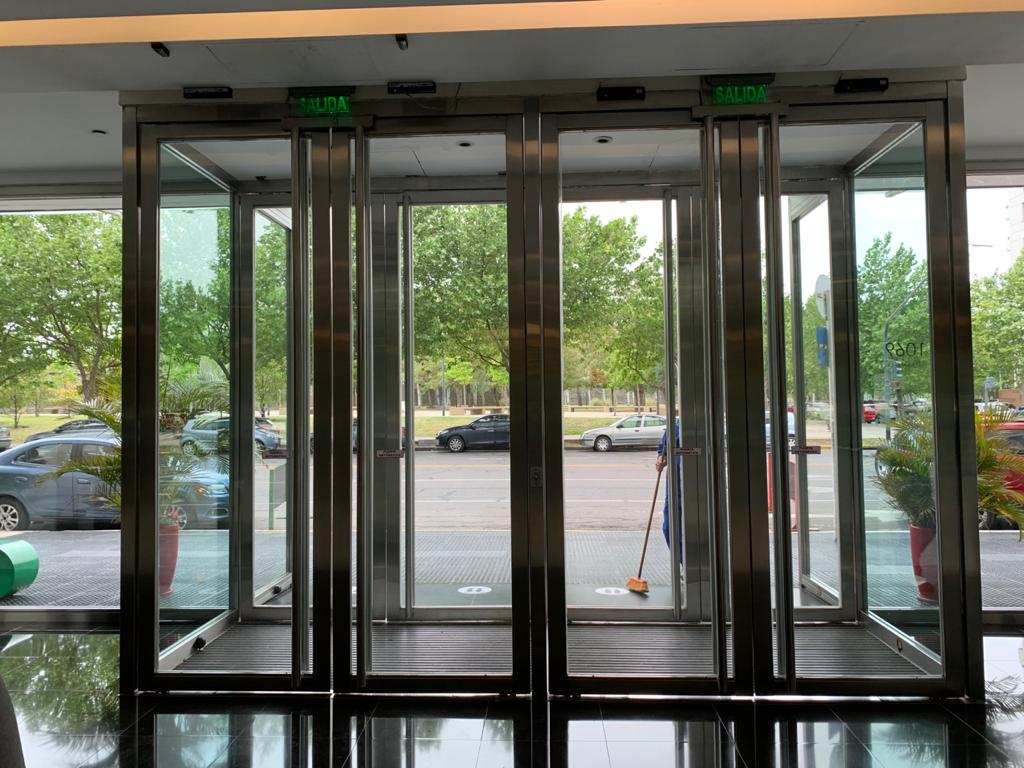Quali sono i componenti chiave di un sistema automatico di motori per porte scorrevoli?
Le porte scorrevoli automatiche sono diventate onnipresenti in varie impostazioni, fondendo perfettamente la comodità con l'estetica moderna. Al centro del loro regolare funzionamento c'è un sofisticato sistema motore che orchestra l'apertura e la chiusura di queste porte. In questo articolo, approfondiamo i componenti essenziali di un motore automatico della porta scorrevole sistema, svelando la tecnologia che alimenta questi silenziosi guardiani degli ingressi moderni.

1. Motore:
Il motore funge da motore del sistema automatico della porta scorrevole. Tipicamente un motore elettrico, converte l'energia elettrica in movimento meccanico, guidando i pannelli delle porte lungo i loro binari designati. I motori possono essere AC (corrente alternata) o DC (corrente continua), ognuno offrendo vantaggi specifici in termini di controllo, efficienza e affidabilità.
2. Meccanismo di azionamento:
Il meccanismo di azionamento è responsabile di tradurre il moto rotazionale del motore nel movimento lineare necessario per spostare i pannelli delle porte. I meccanismi di azionamento comuni includono cinghie, catene o ingranaggi collegati al motore. La scelta del meccanismo di azionamento influenza fattori quali velocità, livello di rumore e prestazioni complessive.
3. Unità di controllo:
L'unità di controllo funge da cervello del sistema, ricevendo input dai sensori e determinando la risposta appropriata. Ospita una scheda logica che interpreta questi input, dettando la velocità, la durata e la direzione del movimento della porta. L'unità di controllo garantisce una perfetta coordinazione tra i vari componenti per prestazioni ottimali.
4. Sensori:
I sensori svolgono un ruolo fondamentale nel sistema automatico delle porte scorrevoli rilevando la presenza di individui o ostacoli nel percorso della porta. I tipi di sensori comuni includono sensori di movimento, sensori a infrarossi o sensori a microonde. Le informazioni raccolte da questi sensori attivano l'unità di controllo per avviare la sequenza di apertura della porta.
5. Microprocessore:
Nei moderni sistemi automatici di porte scorrevoli, un microprocessore aggiunge un ulteriore livello di controllo e adattabilità. Il microprocessore monitora e regola continuamente i movimenti delle porte, garantendo prestazioni ottimali, reattività agli ingressi dei sensori e conformità ai protocolli di sicurezza. Migliora la precisione e l'intelligenza dell'intero sistema.
6. Sistema di ingranaggi:
I sistemi di ingranaggi regolano il movimento della porta, convertendo la forza di rotazione dal motore nel movimento lineare richiesto per lo scorrimento. Diverse configurazioni di ingranaggi, come ingranaggi senza fine o ingranaggi elicoidali, fattori di impatto come il livello di rumore, l'efficienza e la fluidità del funzionamento della porta.
7. Caratteristiche di sicurezza:
I motori automatici delle porte scorrevoli sono dotati di una serie di funzioni di sicurezza per prevenire incidenti. Questi possono includere sensori di rilevamento degli ostacoli che fermano o invertono la porta quando rilevano un ostacolo. I sistemi frenanti di emergenza arrestano rapidamente la porta in caso di malfunzionamenti o emergenze, garantendo la sicurezza dell'utente.
8. Alimentatore di emergenza:
Per mantenere la funzionalità durante le interruzioni di corrente, i sistemi automatici delle porte scorrevoli spesso includono un alimentatore di emergenza. Ciò garantisce l'accesso continuo e il funzionamento delle porte, soprattutto in situazioni critiche. L'alimentatore di emergenza è tipicamente progettato per fornire energia sufficiente per le funzioni essenziali.
9. Meccanismo manuale di override:
In situazioni in cui il funzionamento manuale diventa necessario, i sistemi automatici di porte scorrevoli sono dotati di un meccanismo manuale di override. Ciò consente agli individui di aprire o chiudere manualmente le porte, fornendo un'opzione di sicurezza in caso di interruzione di corrente o malfunzionamento del sistema.
10. Controllo della velocità variabile:
Molti motori automatici delle porte scorrevoli offrono il controllo della velocità variabile, consentendo movimenti regolari e regolabili delle porte. Questa funzione è particolarmente utile nelle aree ad alto traffico, consentendo di aprire rapidamente le porte per entrare o uscire rapidamente e rallentando per un funzionamento più controllato durante il normale utilizzo.
Conclusione:
Il sistema motore automatico delle porte scorrevoli è un sofisticato assemblaggio di componenti che lavorano in armonia per fornire un accesso senza soluzione di continuità e migliorare la funzionalità degli ingressi moderni. Dal motore e meccanismo di azionamento ai sensori, alle unità di controllo e alle caratteristiche di sicurezza, ogni componente svolge un ruolo fondamentale nella creazione di un funzionamento efficiente e sicuro della porta. Mentre la tecnologia continua a progredire, le innovazioni in questi componenti contribuiscono alla continua evoluzione dei sistemi automatici di porte scorrevoli in varie applicazioni architettoniche.







